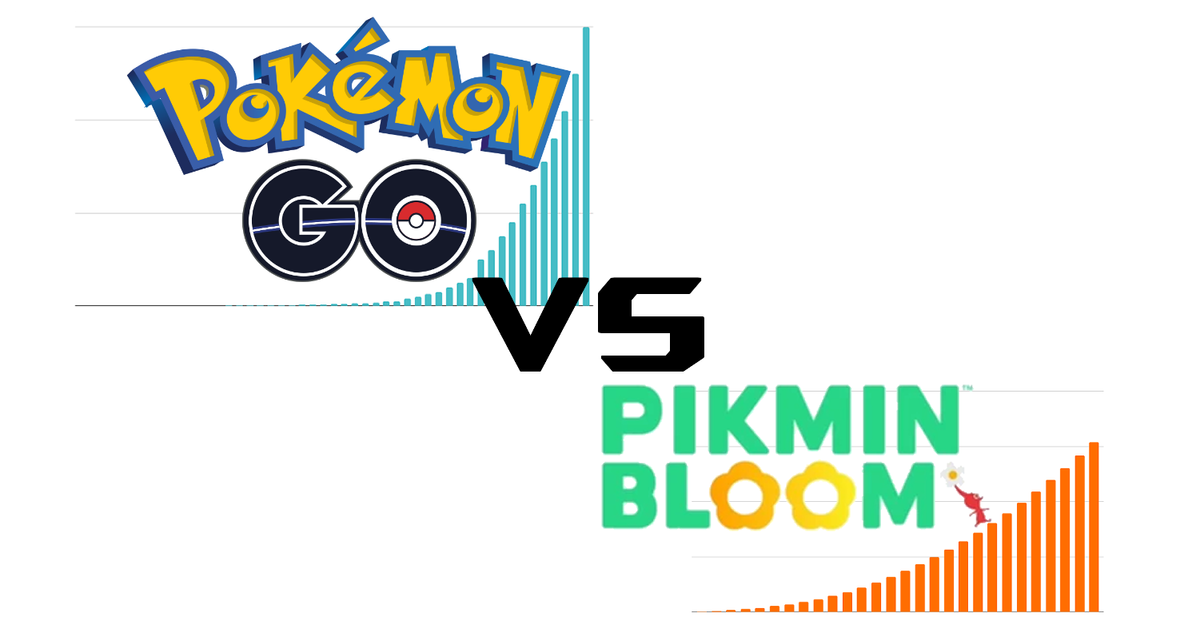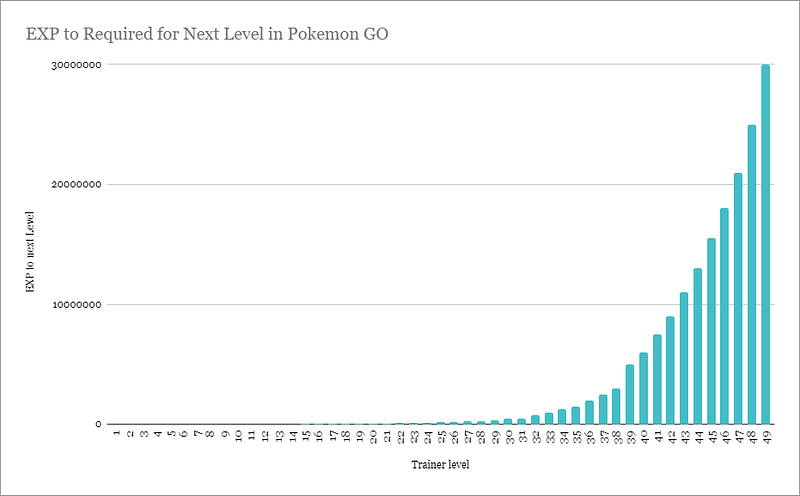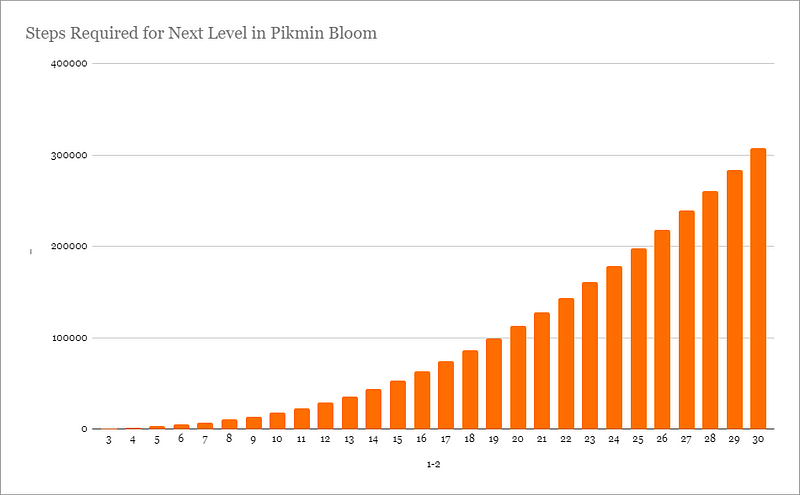Levelling up: How Pikmin Bloom fixed what Pokemon Go got wrong.
What Pokemon Go got wrong, what Pikmin Bloom got right, and what Niantic (and you!) can do better.

(This article was originally posted on medium.com before being edited and reposted here.)
Video games really like systems where you level up. Sadly, many do it in a way that frustrates players, and only a few do it close to properly. Niantic (famous for Pokemon GO), has done both.
In the summer of 2016, Niantic released Pokemon GO. It does levels terribly. In 2021, they released Pikmin Bloom, which does levels much better. Let’s talk about why.
EXP at its best
Experience curves, at their best, encourage and reward growth and exploration. If you want the fancy new level, you aren’t allowed to grind the same low-level mobs for it — while they used to bring you a level up after a handful, it would now take you hours to chisel away a fragment of that experience bar.
A seamlessly integrated experience system feels like it grows as you grow as a player. So let’s take a look at…
How Pokemon GO got it wrong
Harshly exponentially growth for requirements
This is a chart of the EXP requirements to get to the next level:

Note that the last few bars are so large that the others might as well not exist compare to them.
Coupled with near-constant EXP accumulation
Worse, the methods of accumulating exp remain relatively stable throughout, with a few things that unlock with further levels. These unlocks do not speed EXP gained per unit player time, but rather give a wider variety of ways of gaining EXP. This does not solve the problem of an exponential requirement curve.
Rather than act as a pressure to do more interesting or difficult things, this curve becomes a wall that requires you to do much more of the same thing. It becomes a noticeable impairment that you can alleviate by either sinking in more time, or paying money.
Weak level rewards, few enhancements to player experience
Now, when I say “player experience”, I do not mean “experience points”, but the things that the player can do. Gyms unlock at level 5. Battles with team rocket unlock at 8. Trading and PVP unlock at 10. Those particular levels feel good, like the player can do more, but for the other levels, there is little to look forward to other than a fistful of items that you probably don’t want, a greater variety of items that do things other items already do, and a raise in CP cap.
How Pikmin Bloom got it better
Now, Pikmin Bloom released in October, 2021. By then, it had had multiple years of running Ingress, Pokemon Go, and a handful of other games. They clearly took lessons learned from them all to make levelling less terrible, with changes such as:
A better level requirements curve
Right off the bat, the requirements are not strictly centered on steps. Each level has another requirement in addition to walking, such as growing a certain kind of pikmin, or performing an expedition. Each of these additional requirements has the player interact with a different feature of the game, encouraging exploration. None of them are egregious uses of time.
Even disregarding that, the curve itself is much gentler.

Notably, the last 5 or so levels' experience requirements do not dwarf the progress of the previous levels as they do in Pokemon GO.
Non-exp level requirements
Pikmin Bloom also introduces requirements aside from steps (experience points). These steer the player into using new level rewards (more on that later), and other features of the game that may be overlooked. It isn’t perfect, but we’ll talk about ways to improve that later in the article.
Steadier rate of more interesting level rewards
Levelling up unlocks more features of the game at a steadier pace. Squad caps are raised every level. Once you unlock challenges, the caps on those are raised with every level as well. This would seem like the equivalent of raised CP limits, but Pikmin Bloom’s take on things is more immediately tied to level-ups. In Pokemon Go, there is a delay in the perceived benefit, requiring additional grinding for candies and stardust individually for each pokemon.
Several levels also include new seedling types, each of which come with their own walking requirements, which encourage more walking, which makes steps more interesting to accumulate. The levelling system also unlocks expeditions (indirectly unlocking postcards), detectors and challenges, which each reward the expanding team and collection of the player’s pikmin. Compare to Pokemon Go, where the feature unlocks are primarily limited to trading and three different kinds of fighting.
An Ideal Levelling System
While I do like Pikmin Bloom’s progression, it isn’t quite the perfect thing I have in mind. Let’s see what my ideal progression system looks like.
Mildly exponential levelling curve
In this way, Pikmin Bloom is good! Moving on.
A fittingly exponential exp gathering curve
Ideally, a progression system eases you into tougher challenges by making them the main way to maintain a reasonable time between levels — doing the older, easier stuff should become inviable, and eventually take forever.
Optional exp bonuses
Pikmin bloom’s level requirements are a good idea, but they shouldn’t be mandatory in other games. Not every system that you would want to incentivize the player to explore will be palatable to every player in a game, and absolutely forcing a player to interact might turn players off the game. The bonuses should be large enough that a player has reason to do them, but not large enough that they end up being just effectively mandatory.
Interesting rewards
The rewards for levelling should be more than raising statistics. They should unlock new features (increasing the complexity of the game and helping determine a learning curve). Ideally, these unlocked features play into the exp gathering curve, increasing the potential experience points earned per unit time.
A perpetual ‘over-level’ system
One reason some games make the final levels a nigh-eternal slog is because they loathe to let the player ‘run out’ of things to do. One way you can solve that is to leave a small carrot for the player. When the player hits a (no-longer growing) cap, let the meter overflow and give them a small stash of consumables.
This way, players don’t feel like any further experience ‘earned’ isn’t thrown into a void. This benefit is similar to that of ‘dailies’, rewarding continued play, but doesn’t come with a daily FOMO pressure on the player.




